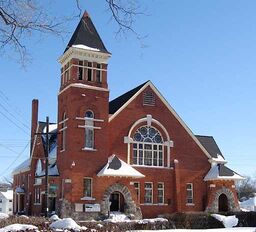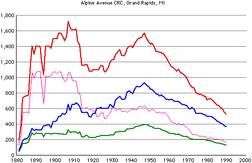
Alpine Avenue CRC, Grand Rapids, MI, 1881-1992
Alpine Avenue was the the third Christian Reformed congregation in Grand Rapids and the first Dutch Reformed church west of the Grand River. It merged with Highland Hills to form Westend Christian Reformed Church in 1992.
History[]
Alpine Avenue (also known as Third) Christian Reformed Church was organized on May 25, 1881 by members of First CRC. Alpine Avenue was the third Christian Reformed congregation in Grand Rapids, Michigan, after First (1857, downtown) and East Street (1879, now Eastern Avenue) - and the first Reformed congregation on the west side of the Grand River. It started out with a 36' x 62' building.
The 1880 U.S. Census had counted 32,016 residents in Grand Rapids, nearly twice the population of a decade earlier. The Dutch-born population had grown at a faster rate. This census counted 7,110 Dutch-born, 2.4 times as many as in 1870. Not counting their American-born offspring, this represented 22% of the Grand Rapids population, the highest level in any census.
Apline Avenue's first pastor, Rev. William H. Frieling, arrived November 26, 1882, and growth was rapid, as this was the only Reformed church on the West Side. In 1886, a 40' x 50' transept was added, increasing seating capacity to 750. And in the fall of 1888, it built a new 50' x 60' church at West and Crosby, which became West Leonard CRC.
Alpine Avenue merged with Highland Hills in 1992 to form Westend CRC.
Historical Details[]
Location[]
- 960 Alpine NW, Grand Rapids, MI 49504 (built 1904)
Pastors[]
- Willem Hendrik Frieling, 1882-86
- Peter Ekster, 1886-1905
- Samuel (Sietse) Volbeda, 1905-11
- John (Jan) Van Lonkhuyzen, 1911-18
- Peter A. Hoekstra, 1919-27
- William Masselink Sr., 1928-42
- Peter Ymen De Jong, 1942-48
- John Thomas Holwerda, 1948-54
- Arthur William Hoogstrate, 1954-61
- George P. Holwerda, 1961-66
- John Henry Bergsma, 1966-90
Daughter Churches[]
- Crosby Street (now West Leonard), 1888
- Broadway Avenue (now Westview), 1893
- Twelfth Street, 1917, cosponsored with West Leonard
- Front Street Mission, 1948-62
Membership Overview[]
Total membership peaked circa 1910 and dropped drastically when Twelfth Street church was launched in 1917. The professing membership peak came circa 1950, and from that point forward, Alpine Avenue CRC went into long-term decline, although it had a period of relative stability from 1974-77. The youth ratio was slightly low and declining toward the congregation's end. The birth rate was half the average and the death rate was triple the average - danger signs for a congregation.
Highland Hill had several peaks and dips in its 41 year history. It grew steadily until the late 60s, then declined slowly until the mid-70s. Growth resumed in 1978 coinciding with a change of pastor. This growth peaked in 1981, with a decline of 13% by 1984. Membership increased in 1985 and 1986, but has dropped 24% since then.
Highland Hills has a very solid youth ratio, with birth and death rates quite close to the average. None of these are danger signs, yet the congregation had been losing members almost every year since 1981.
As the two churches merged, both were without pastors.

Membership data, Alpine Ave. CRC, Grand Rapids, MI
Overall Membership Data[]
Green (lower) line shows membership in families; blue (middle), professing members; red (top), total members; and magenta (thin), non-professing members.

Youth ratio, Alpine Ave CRC, Grand Rapids, MI
Youth Ratio[]
Red line shows nonprofessing members as a percentage of total membership.

Five year growth rate, Alpine Ave CRC, Grand Rapids, MI
Five Year Growth Rate[]
Red line shows five year growth rate. A five year growth rate between 10% and -10% is considered stable; greater than 10% indicates a growing congregation; one below -10% indicates a church in decline. This makes no allowance for daughter churches.
Data source: Yearbooks of the Christian Reformed Church. Dates are year prior to publication date since data is gathered at the end of one year and published in the next.
Sources
- History of the City of Grand Rapids, Michigan , Albert Baxter, 1891. Especially the section on Alpine Avenue Holland Christian Reformed Church